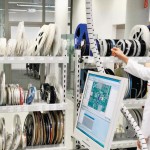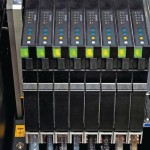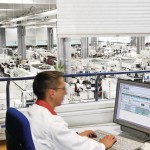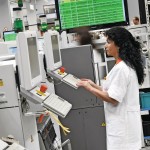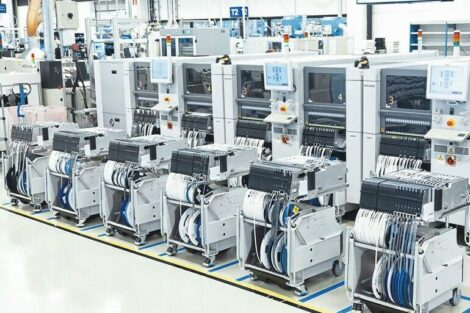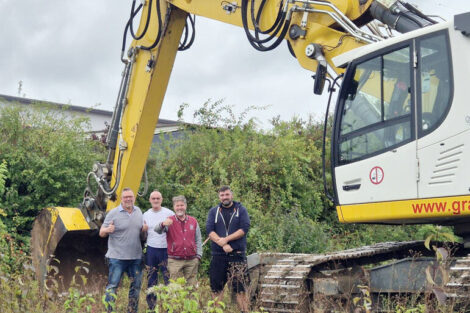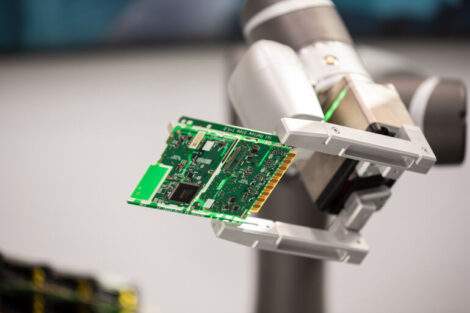Electronics manufacture is a process that is based on the separation of labor. There are production planners, line managers, machine operators, production managers and a whole lot more. They all perform different jobs in separate processes. In many industries, production experts consider the availability of consistent software support for differentiated, role-based workflows to be an important prerequisite for additional efficiency improvements. ASM Assembly Systems now picks up on this trend for the Productronica trade show. As the first equipment supplier in electronics manufacturing, the company presents hardware, software and service options as workflow solutions that make the entire production process much more efficient.
ASM Assembly Systems, Munich (Germany)
People who come from traditional industries like the automotive or machine-building sometimes can’t believe what they are seeing when they look at the job of a production scheduler in the electronics industry. Why? Because this person must perform the job under great time pressure, but with insufficient support from suitable software and systems.
For example, orders coming down from the ERP system are frequently based on insufficient material availability checks. A classic scenario: Orders received from the ERP system require 5,000 components each on three separate lines. The 20,000 components of this type that are currently in stock are theoretically sufficient, however, they are spread over two reels. ERP systems rarely maintain this kind of information. Most schedulers are forced to sequence and distribute their production jobs over the different SMT lines just based on instinct and experience – rarely with help from appropriate software. The reason for this handicap: traditional software permits only line-based optimization. And let’s not forget: once the scheduling work has been done, the information must usually be put down on paper and manually forwarded to the warehouse, the setup preparation department and the line. All of these steps take time. And when a rush order complicates the situation even further, schedulers like to switch to informal “special processes” instead of properly planning and distributing such orders via the in-house IT systems. Not only the schedulers are affected: also line operators, line managers and production managers have only an insufficient array of tools to support them in their work.
Lack of workflow support – a problem with many causes
The reasons for this situation are various. The electronics industry with its SMT production processes is relatively young. Most innovations were driven not so much by the need for more output, but by the need to accommodate new components and technologies. This left little time to worry about optimizing the entire manufacturing process. Another reason: Highly automated production sites are usually supported by hardware-oriented equipment suppliers, who focus more on controlling their machines and less on all-encompassing software needed to provide process-oriented support for various operator groups.
Against this backdrop, it only makes sense that Siplace is focusing on software-based workflow support and making it the overarching theme of its presence at this year’s Productronica trade show. The Siplace team recognized the growing importance of software in the increasingly flexible area of electronics production early on. As a result, the company can built on a large team of software developers and is able to offer unique hardware and software in the form of integrated solutions. The highly flexible setup concepts of Siplace provide an excellent example of the success of this approach. In addition, Siplace placement machines have for many years set the standard in terms of performance and quality. The company is widely considered a technology and innovation leader, and workflow management is another opportunity to set itself apart and offer significant customer benefits.
Workflow support for production scheduling
So let us rise the questions: what does Siplace have to offer in terms of workflow support, and how is this new focus area reflected in the company’s development priorities and new products? The production scheduler’s job provides the best opportunity to demonstrate the first tangible benefits. This person’s job is to optimize the detailed scheduling of approved production orders while balancing delivery reliability, lot sizes and efficiency.
To make this job easier, Siplace is unveiling SiCluster MultiLine at this year’s Productronica. The software enables the planner for the first time to optimally schedule production jobs across multiple lines. The program takes line-related restrictions and configurations (placement heads, feeders, board tests/inspection stages, maintenance intervals, etc.) fully into account. It spreads the products across the lines and groups them into setup families or manufacturing clusters based on the scheduler’s selection of maximum output or minimum setup effort.
The Siplace Material Manager delivers improvements in the area of stock availability checking. Since the software records materials package-based with individual UIDs and uses real machine data from the Siplace equipment on the basis of placement programs and lot sizes to determine the consumption data, it maintains much more accurate component inventory data than an ERP system would deliver. As a result, production scheduling becomes more accurate, and unwanted stops resulting from faulty minimum stock-on-hand checks are remarkably minimized. By running reports on real throughput times, the scheduler can also make more realistic assumptions regarding the throughput time of equal or similar jobs.
Link to setup processes and machine operation
The material logistics system can also be used to automatically transfer the scheduling data to downstream processes and procedures. The component warehouse and the setup preparation area provide good examples: Once the production schedule has been finalized, the Siplace Material Manager can automatically send travel-optimized pick lists to the component warehouse.
The software even controls automated storage systems such as Kardex. Additionally, Siplace Material Manager together with Siplace Setup Center handle specific procedures such as MSD handling (i.e., the storage and control of exposure times for moisture sensitive devices).
Reduce unnecessary trips and inventory transactions
The setup preparation area shows how well the specific production expertise and experience of the Siplace engineers have been integrated into the new solutions. Since current planning systems provide no transparency across all production jobs and setups, component reels that are no longer needed in a product must be returned to the main component warehouse and posted back into inventory. This is often a wasteful step, because in many cases the reel will soon be needed on the same line or others again for one or more of the upcoming production jobs. This posting back to and removing from inventory involves unnecessary effort and travel time from the operating staff.
The Active Feeder Rack from Siplace provides a much smarter, workflow-oriented solution for the setup manager, because it provides an intermediate storage site for feeders and components that will soon be needed again, and the Siplace Material Manager keeps track of them with the setup area functioning as a valid storage location. But there is even more in the Siplace portfolio to find: With Setup Preparation Guidance from the company, the feeders stored in the electronically linked Active Feeder Rack can signal via their LEDs which units will have to be returned to line soon and which can be returned to the main inventory.
No-stop setup concepts and other production aids
It is the line operators’ duty to make sure that the production runs continuously by splicing on new reels and requesting more materials when needed. Here, too, Siplace demonstrates with its solutions what huge benefits role-based workflow solutions can deliver.
The Siplace Line Monitor, for example, makes the operating staff’s work a lot easier. instead of displaying only the status of just a single machine, it shows the entire line. No matter where on the line the operator is currently located, the employee can check all the machines at a glance and see on which machine and feeder position the next splice job will have to be performed. This puts an end to the measure of “splicing for safety’s sake” with reels that may be running down, but would be sufficient for the current job.
The intelligent setup concepts also reduce pressure on the production staff. Random Setup, Constant Tables and Split Tables don’t just speed up the changeover process, but make the operators’ job a lot easier because components can remain on the line for multiple setups (Constant Tables) or be set up in any available slot (Random Setup).
Workflows harbor efficiency improvements of the future
The few examples above show how software-supported, role-specific workflows can make electronics production easier, more reliable and more efficient, as a conclusion we can state. By setting the course in this sophisticated field, Siplace developers are demonstrating at this year’s Productronica that they have taken a significant step ahead of other equipment suppliers. Besides the above examples for production schedulers, setup managers and line operators, the company also presents solutions for process engineers (NPI tools, program data management) and production managers (KPI monitoring, traceability). While some of these may still be toolboxes rather than fully integrated applications, the tendency is clear, as are the underlying reasons: An electronics manufacturing site in which each and every employee has the proper tools and systems to perform the job and carry out the duties will always be significantly faster and more efficient.
Productronica, Booth A3.377, 363, 480 and B2.225
zusammenfassung
Bisher konnten Systeme für die Fertigungsplanung die Daten für die nötige Produktionnvorbereitung und eine erschöpfende Übersicht für alle hier stark segmentierten Aufgaben in der Regel nur partiell liefern – und dann auch nur über eine einzelne Linie. Mit den nun von Siplace erstmalig vorgestellten Lösungen und Tools für das Engineering eines umfassenden Workflows über alle Linien in einer Fertigung lassen sich alle einzelnen Jobs in solchen stark fragmentierten und komplexen Umgebungen rascher und effizienter (somit auch kostengünstiger) durchführen. Denn jeder damit befaßte Mitarbeiter erhält aus diesem optimierten Workflow-System stets die Informationen und Daten, die für die effiziente und komplikationslose Bearbeitung benötigt werden.
Jusqu’à présent, les systèmes pour la planification de la fabrication ne pouvaient en règle générale que fournir partiellement les données pour la préparation nécessaire de la production et un aperçu exhaustif pour toutes les tâches fortement segmentées dans le cas présent – et encore uniquement au travers d’une seule ligne. Avec les solutions et les outils désormais présentés pour la première fois par Siplace et destinés à l’engineering d’un workflow complet, tous les différents jobs peuvent être réalisés de manière plus rapide et plus efficace dans un environnement aussi fortement fractionné et complexe (ce qui permet également d’améliorer les coûts). En effet, chaque collaborateur concerné obtient toujours de la part de ce système workflow optimisé, les informations et les données qui lui sont nécessaires pour un traitement efficace et sans complications.
Share:




